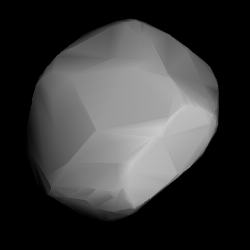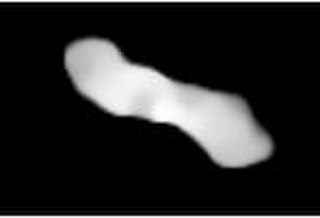
216 Kleopatra is a large M-type asteroid with a mean diameter of 120 kilometers and is noted for its elongate bone or dumbbell shape. It was discovered on 10 April 1880 by Austrian astronomer Johann Palisa at the Austrian Naval Pola Observatory, in what is now Pula, Croatia, and was named after Cleopatra, the famous Egyptian queen. It has two small minor-planet moons which were discovered in 2008 and later named Alexhelios and Cleoselene.
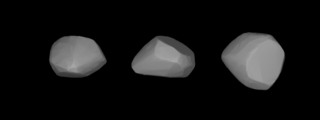
71 Niobe is a stony Gallia asteroid and relatively slow rotator from the central regions of the asteroid belt, approximately 90 kilometers in diameter. It was discovered by the German astronomer Robert Luther on 13 August 1861, and named after Niobe, a character in Greek mythology. In 1861, the brightness of this asteroid was shown to vary by astronomer Friedrich Tietjen.

128 Nemesis is a large 180 km main-belt asteroid, of carbonaceous composition. It rotates rather slowly, taking about 78 hours to complete one rotation. Nemesis is the largest member of the Nemesian asteroid family bearing its name. It was discovered by J. C. Watson on 25 November 1872, and named after Nemesis, the goddess of retribution in Greek mythology.
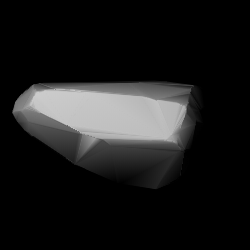
136 Austria is a main-belt asteroid that was found by the prolific asteroid discoverer Johann Palisa on 18 March 1874, from the Austrian Naval Observatory in Pola, Istria. It was his first asteroid discovery and was given the Latin name of his homeland.
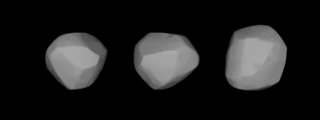
146 Lucina is a main-belt asteroid that was discovered by Alphonse Borrelly on June 8, 1875, and named after Lucina, the Roman goddess of childbirth. It is large, dark and has a carbonaceous composition. The spectra of the asteroid displays evidence of aqueous alteration.
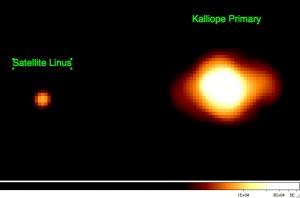
22 Kalliope is a large M-type asteroid from the asteroid belt discovered by J. R. Hind on 16 November 1852. It is named after Calliope, the Greek Muse of epic poetry. It is orbited by a small moon named Linus.

152 Atala is a large main belt asteroid that was discovered by brothers Paul Henry and Prosper Henry on 2 November 1875, but the discovery was credited to Paul. It is a type D asteroid, meaning that it is composed of carbon, organic rich silicates and possibly water ice.

208 Lacrimosa is a main-belt asteroid that was discovered by Austrian astronomer Johann Palisa on October 21, 1879, in Pola. The name derives from Our Lady of Sorrows, a title given to Mary, the mother of Jesus. It is orbiting the Sun at a distance of 2.89320 AU with a period of 4.92 yr and an eccentricity (ovalness) of 0.013. The orbital plane is inclined at an angle of 1.7° to the plane of the ecliptic.
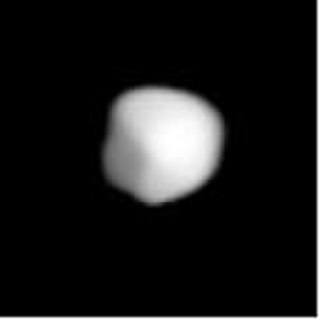
230 Athamantis is a fairly large main-belt asteroid that was discovered by the German-Austrian astronomer K. de Ball on September 3, 1882, in Bothkamp. It was his only asteroid discovery. The asteroid was named after Athamantis, daughter of Athamas the mythical Greek king of Orchomenus.
234 Barbara is a main belt asteroid that was discovered by German-American astronomer Christian Heinrich Friedrich Peters on August 12, 1883, in Clinton, New York. The object is orbiting the Sun with a semimajor axis of 2.385 AU, a period of 3.68 years, and an eccentricity of 0.25. The orbital plane is inclined by 15.37° to the plane of the ecliptic. It is classified as a stony S-type asteroid based upon its spectrum. The mean diameter of this object is estimated as 45.6 km. It has a rotation rate of 26.5 hours, or a little over a day. It is possibly named for Saint Barbara, patron saint of mathematicians.

308 Polyxo is a main-belt asteroid that was discovered by A. Borrelly on March 31, 1891, in Marseilles. It is orbiting the Sun at a distance of 2.75 AU with a low orbital eccentricity (ovalness) of 0.04 and a period of 4.56 yr. The orbital plane is tilted at an angle of 4.36° to the plane of the ecliptic.
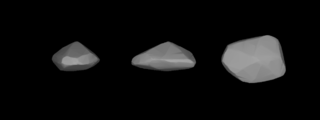
512 Taurinensis, provisional designation 1903 LV, is a stony asteroid and large Mars-crosser on an eccentric orbit from the inner regions of the asteroid belt, approximately 20 kilometers in diameter. It was discovered on 23 June 1903, by astronomer Max Wolf at the Heidelberg-Königstuhl State Observatory in southwest Germany. The asteroid was named after the Italian city of Turin. It is the 4th-largest Mars-crossing asteroid.
785 Zwetana is a minor planet orbiting the Sun that was discovered by Adam Massinger, an assistant at the Heidelberg Observatory, on March 30, 1914. It was named for the daughter of Kiril Popoff, a Bulgarian astronomer. This asteroid is orbiting 2.57 AU from the Sun with an eccentricity (ovalness) of 0.21 and a period of 4.12 yr. The orbital plane is inclined by an angle of 12.8° to the plane of the ecliptic.
914 Palisana, provisional designation 1919 FN, is a Phocaean asteroid from the inner regions of the asteroid belt, approximately 77 kilometers in diameter. It was discovered by German astronomer Max Wolf at Heidelberg Observatory on 4 July 1919.
925 Alphonsina, provisional designation 1920 GM, is a stony Hansian asteroid from the central region of the asteroid belt, approximately 58 kilometers in diameter. It was discovered on 13 January 1920, by Catalan astronomer Josep Comas i Solà at the Fabra Observatory in Barcelona, Spain. The S-type asteroid has a rotation period of 7.88 hours. It was named for the Spanish Kings Alfonso X and Alfonso XIII.
1143 Odysseus, provisional designation 1930 BH, is a large Jupiter trojan located in the Greek camp of Jupiter's orbit. It was discovered on 28 January 1930, by German astronomer Karl Reinmuth at the Heidelberg Observatory in southwest Germany, and later named after Odysseus, the legendary hero from Greek mythology. The dark D-type asteroid has a rotation period of 10.1 hours. With a diameter of approximately 125 kilometers, it is among the 10 largest Jovian trojans.
3800 Karayusuf, provisional designation 1984 AB, is a Mars-crossing asteroid and suspected binary system from inside the asteroid belt, approximately 2.5 kilometers in diameter. It was discovered on 4 January 1984, by American astronomer Eleanor Helin at the Palomar Observatory in California. The S/L-type asteroid has a short rotation period of 2.2 hours. It was named after Syrian physician Alford Karayusuf, a friend of the discoverer.

1459 Magnya, provisional designation 1937 VA, is a basaltic, slightly elongated asteroid from the outer regions of the asteroid belt, approximately 20 kilometers in diameter. Discovered by Grigory Neujmin at the Simeiz Observatory in 1937, this background asteroid was later named from the Latin word "Magnya", which means "clear, bright, wonderful" when literally translated into Russian. It is the only known basalt asteroid orbiting beyond 4 Vesta.

1366 Piccolo, provisional designation 1932 WA, is an asteroid from the background population of the outer asteroid belt, approximately 28 kilometers in diameter. It was discovered on 29 November 1932, by astronomer Eugène Delporte at the Royal Observatory of Belgium in Uccle. The asteroid was named after Auguste Cauvin, chief-editor of the Belgian newspaper Le Soir.
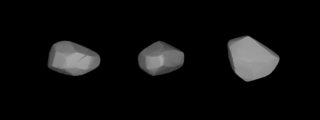
1263 Varsavia, provisional designation 1933 FF, is an asteroid from the central region of the asteroid belt, approximately 40 kilometers in diameter. It was discovered on 23 March 1933, by Belgian astronomer Sylvain Arend at Uccle Observatory in Belgium. It is named for the city of Warsaw.
